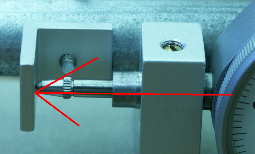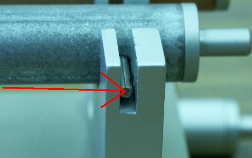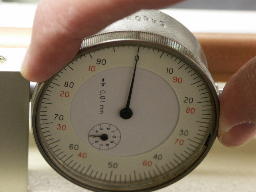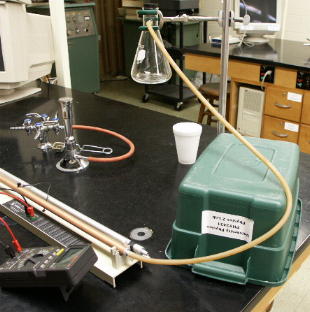Caution !!!
Since this lab deals with steam/water vapor, and a hotplate ...
arrange the lab equipment carefully to protect any of the computer
equipment (your laptops!!).
The general layout of the equipment for this lab
- 1 hotplate heats the water in the flask
- 1 flask with rubber hose
- 1 thermal apparatus with 3 different metal rods
- 1 multimeter to measure resistance (your multimeter may look different)
- 1 thermal glove (not shown)
- 1 meterstick (not shown)
The "lock down" at one end
The point of the lab is to heat up the metal rod a known number of degrees, and measure the change in length of the rod. To do that, we need to be able to accurately measure that change in length. There is a moveable pin (with a dial) on one end, and we want to "lock down" the other end.
Here is a picture showing an example rod - notice the two small rods fit into that "U" notch, that keeps the rod from moving to the right (but could still be taken out if necessary). [One apparatus has a "V" shape at one end.]
The other end of the rod assembly has an "L" shaped piece that touches the moveable post connected to the dial (shown in the middle photo). The horizontal post is already compressed in slightly when it touches that L bracket ... so as the rod expands to the left, the post will come "out" from the dial, and the dial will rotate, to indicate the expansion distance.
Note : it is important that the dial end (show in the left picture) is under compression when the L bracket is fitted in place .. the pointer connected to the dial needs to be able to move to the left (in that picture) as the rod expands. So, before you put the L bracket in place, make sure that the pointer connected to the dial is "longer" than where the L bracket will go, thus you have to press the pointer in to fit the L bracket in place.
The red arrows show the endpoints where we want to measure the original length of the rods (L0). Make sure you measure each rod individually, they may not all be the same length.


How to read the dial?
Here we can see the dial that will measure the change in length (one time around is 1 mm). The outer ring can be rotated to "zero" the dial. (Note, this dial is made to measure expansion or contraction, that's why it starts under some compression .. and that's why the needle could rotate either clockwise or counterclockwise ... for our expansion, it will go only one direction, once we zero it.) We will be measureing from the RED numbers on the dial (that is, the needle will follow the red numbers as the rod expands).
Once you have connected all the hoses, and started boiling the water, you should "reset" the dial reading to zero. But, wait until the last minute, as you start heating the water, because all the adjustments to the hoses, etc. will cause some fluctuations in the needle reading.
Also, keep an eye on the needle to make sure you notice if it goes all the way around (metals with large coefficents might have a needle go around more than once .. like aluminum).
Again, once around the dial is 1 mm, so all those "divisions" on the dial are out of 1 mm.

Make sure there are no "valleys" in the steam hose
This picture shows a "downhill only" path from the steam flask to the upper nozzle on the apparatus - make sure the hose does not "sag" into a trough, and then up to the nozzle (water will condense there, fill the hose, and block the flow of steam).
Hopefully the rubber hoses will be smaller than in this picture, so you shouldn't have too much trouble getting the "no dips" configuration to work .. remember to zero the dial AFTER you have done all the fiddling with the equipment.
This picture also shows the bunsen burner - we will be using a hotplate.

Measuring the Temperature .. via an Ohmmeter
This apparatus measures the temperature with a thermal resistor (thermister), and a calibration curve. Using the multi-meter, set to read Ohms as shown in the lower picture, we can record the "resistance" of the initial room temperature, and check the scale on the apparatus to convert that to the temperature value. We do the same thing at the end to find the final "steam" temperature.
You can either interpolate the numbers on the scale to figure out your temperature, or you can use the graphs that are provided in the lab to let you convert the resistance to the temperature reading.
How do you know when the final expansion has been reached? When the dial stops turning, and the "thermometer" stops rising, you can assume that the rod has expanded as far as it can. You should take the final readings of both the dial and the thermometer.
Note : this is the first year with these tubes ... so we are still learning how to best make use of them. The final temperatures seem to be running in the high 80s, instead of the assumed ~100 degrees of the steam temperature. Try the numbers you find from the thermister ... if you get good values for the coefficients of thermal expansion, great! If not, try using 100 degrees as the final temperature.
